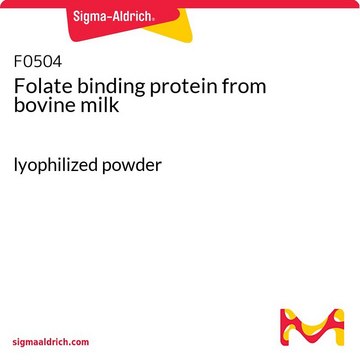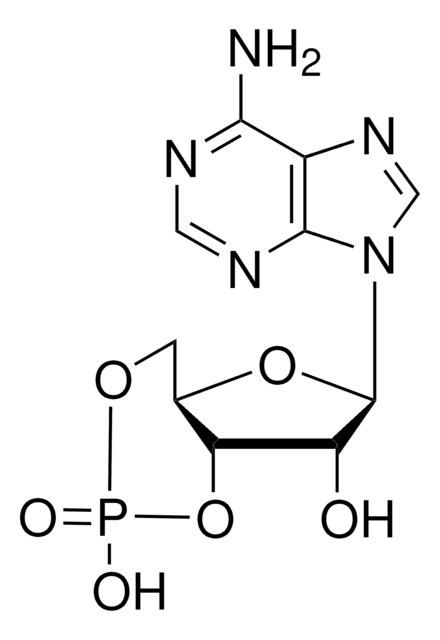P5511
Protein Kinase A from bovine heart
≥0.8 units/μg protein, lyophilized powder
Sinónimos:
Protein Kinase, 3′,5′-cyclic-AMP-dependent from bovine heart
Iniciar sesiónpara Ver la Fijación de precios por contrato y de la organización
About This Item
Número de CAS:
Número MDL:
Código UNSPSC:
12352204
eCl@ss:
32160410
NACRES:
NA.77
Productos recomendados
Formulario
lyophilized powder
Nivel de calidad
actividad específica
≥0.8 units/μg protein
composición
Protein, ≥70%
temp. de almacenamiento
−20°C
Información sobre el gen
cow ... PRKACA(282322) , PRKACB(282323)
¿Está buscando productos similares? Visita Guía de comparación de productos
Descripción general
Protein Kinase A (PKA) is a serine/threonine kinase, which exists as a tetrameric holoenzyme.
Aplicación
Protein Kinase A from bovine heart has been used to determine its activity using a molecular beacon probe. It has also been used to study the interaction of staurosporine with the ATP-binding site of kinases.
Protein Kinase A from bovine heart has been used to inhibit the phosphorylation of myosin.
Acciones bioquímicas o fisiológicas
Protein Kinase A (PKA) inhibits hormone-sensitive lipase translocation from cytosol to storage droplets and blocks lipolysis. It regulates apoptosis, mitochondrial respiration and ATP synthesis. PKA is modulated by protease calpain.
Many 3′,5′-cyclic AMP dependent protein kinases have been reported. Structural studies (Traugh, J.A., et al., Meth. Enzymol., 38, 290 [1974]) show the presence of at least two subunits, the regulatory subunit and the catalytic subunit. When both units are linked together, the catalytic activity is inhibited. However, when the cyclic-AMP binds to the regulatory subunit, the catalytic subunit is released and can then catalyze the transfer of phosphate from ATP to various proteins.
Envase
Package size based on protein content
Definición de unidad
One unit will transfer 1.0 picomole phosphate from ATP to hydrolyzed and partially dephosphorylated casein per minute at pH 6.5 at 30°C in the presence of cyclic AMP, determined by measuring the production of ADP.
Forma física
Crude lyophilized powder containing EDTA and potassium phosphate, pH 7.5.
Nota de preparación
Fractionated essentially by procedure of Gilman, A., Proc. Natl. Acad. Sci. USA, 67, 305 (1970).
Nota de análisis
Protein determined by biuret.
Inhibidor
Referencia del producto
Descripción
Precios
Código de clase de almacenamiento
11 - Combustible Solids
Clase de riesgo para el agua (WGK)
WGK 3
Punto de inflamabilidad (°F)
Not applicable
Punto de inflamabilidad (°C)
Not applicable
Equipo de protección personal
Eyeshields, Gloves, type N95 (US)
Elija entre una de las versiones más recientes:
¿Ya tiene este producto?
Encuentre la documentación para los productos que ha comprado recientemente en la Biblioteca de documentos.
Los clientes también vieron
Cardiomyocyte Hypocontractility and Reduced Myofibril Density in End-Stage Pediatric Cardiomyopathy.
Ilse A E Bollen et al.
Frontiers in physiology, 8, 1103-1103 (2018-01-10)
Dilated cardiomyopathy amongst children (pediatric cardiomyopathy, pediatric CM) is associated with a high morbidity and mortality. Because little is known about the pathophysiology of pediatric CM, treatment is largely based on adult heart failure therapy. The reason for high morbidity
Signaling the signal: Protein Kinase a (PKA) inhibition by insulin-formed H2O2 and reactivation by thioredoxin
de Pina MZ, et al.
The Journal of Biological Chemistry (2008)
Simple fluorescence-based detection of protein kinase A activity using a molecular beacon probe
Journal of Bioenergetics and Biomembranes (2017)
Alkylation of Staurosporine to Derive a Kinase Probe for Fluorescence Applications
Dr. Alexandar
Chemistry of Materials (2016)
Nitroglycerine-and isoprenaline-induced vasodilatation: assessment from the actions of cyclic nucleotides
Itohy T, et al.
British Journal of Pharmacology, 84(2), 393-406 (1985)
Nuestro equipo de científicos tiene experiencia en todas las áreas de investigación: Ciencias de la vida, Ciencia de los materiales, Síntesis química, Cromatografía, Analítica y muchas otras.
Póngase en contacto con el Servicio técnico














